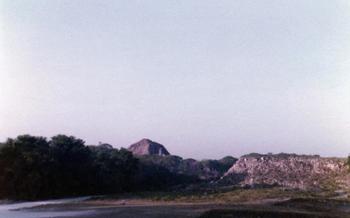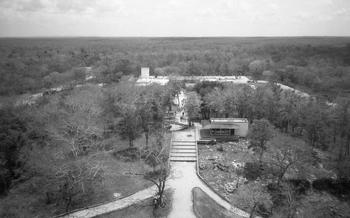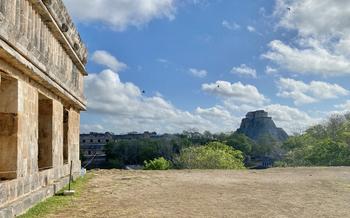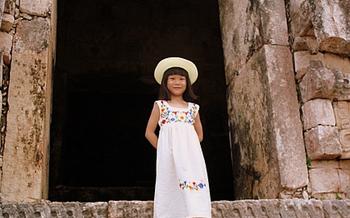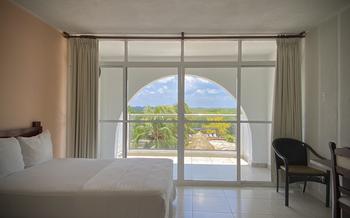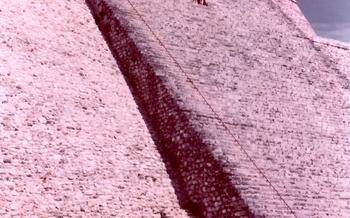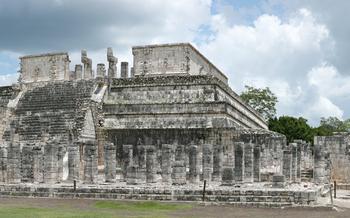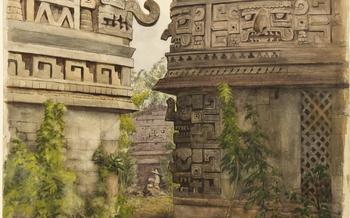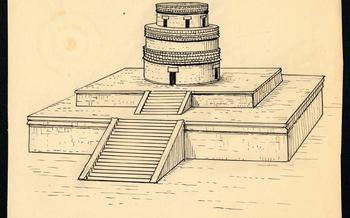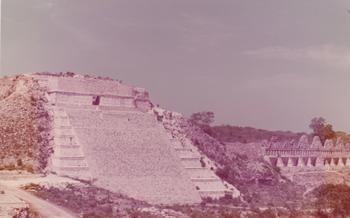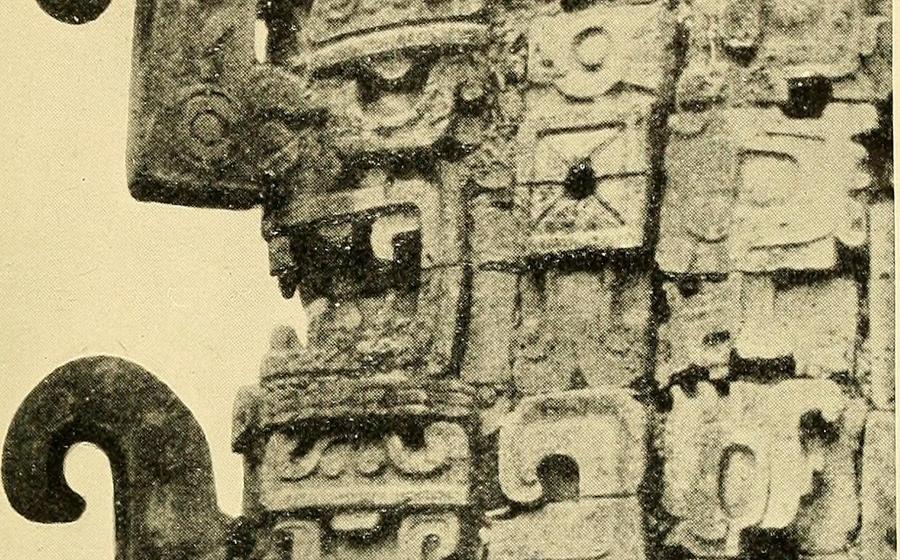
Kabah
- Historical Significance
- Architectural Wonders
- Unique Features
- Exploration and Discovery
- Transportation
- Entrance Fees
- Hours of Operation
- Facilities
- Weather Conditions
- Cultural Sensitivity
- Photography Tips
- Guided Tours
- Nearby Attractions
- Accommodation
- Insider Tip:
Historical Significance
Journey back in time to the ancient Maya city of Kabah, which flourished between 600 and 900 AD. Strategically positioned on a prominent trade route, Kabah served as a regional center, connecting diverse Maya communities and facilitating the exchange of goods and ideas. Its architecture and culture reflect the influence of other prominent Maya cities, such as Chichén Itzá and Uxmal, showcasing a blend of artistic styles and traditions that shaped the Maya civilization. Explore the ruins of Kabah to unravel the stories of its past, immerse yourself in its rich history, and gain insights into the lives of the Maya people who once called this remarkable city home.
Architectural Wonders
Kabah boasts impressive ruins that showcase the architectural prowess of the ancient Maya. The Codz Poop, a sprawling palace complex, captivates visitors with its intricate carvings and sculptures, depicting scenes from Maya mythology and daily life. Adorned with hundreds of stone masks representing the rain god Chaac, the Templo de las Máscaras stands as a testament to the Maya's reverence for water. The Palacio de las Columnas, with its series of rooms supported by massive columns and decorated with bas-reliefs, offers a glimpse into the grandeur of Maya architecture. These architectural wonders, with their unique styles and intricate details, transport visitors back in time, allowing them to appreciate the artistry and ingenuity of the ancient Maya.
Unique Features
Kabah boasts a distinctive architectural style that sets it apart from other Maya cities. Its rounded corners and Puuc-style motifs create a unique aesthetic that is both visually appealing and historically significant. The Chaac masks, a prominent feature of Kabah's architecture, hold particular importance. Believed to represent the rain god Chaac, these masks were intricately carved and placed on the facades of buildings to invoke divine favor and ensure a bountiful water supply.
The water management system at Kabah is another remarkable feat of Maya engineering. The city's reservoirs and canals were designed to capture and store rainwater, providing a reliable source of water for the population during the dry season. This sophisticated system allowed Kabah to flourish even in the challenging environmental conditions of the Yucatán Peninsula.
Exploring these unique features of Kabah offers visitors a glimpse into the ingenuity and resourcefulness of the ancient Maya civilization. By delving into the details of the architecture, water management system, and religious beliefs, visitors can gain a deeper appreciation for the complexity and sophistication of Maya society.
Exploration and Discovery
Explore the ancient ruins of Kabah at your own pace, wandering through the site and capturing stunning photographs of the intricate carvings and sculptures. Take your time to marvel at the unique architectural style, characterized by rounded corners and Puuc-style motifs, and learn about the significance of the Chaac masks that adorn many of the buildings. Discover the impressive water management system, including reservoirs and canals, which sustained Kabah's population.
Consider combining your visit to Kabah with other nearby archaeological sites, such as Uxmal and Sayil, to create a comprehensive Maya exploration experience. This will allow you to gain a deeper understanding of the region's rich history and culture. Guided tours are available to provide insights into the history, culture, and architecture of these ancient cities.
Transportation
Reaching Kabah from Chichén Itzá:
When planning your journey to Kabah from Chichén Itzá, consider the various transportation options available to suit your preferences and budget.
-
Rental Car or Private Transportation: For the ultimate flexibility and convenience, opt for a rental car or private transportation. This allows you to set your own pace, explore the region at your leisure, and make spontaneous stops along the way. It's the ideal choice for those seeking independence and the freedom to customize their itinerary.
-
Public Transportation: For a more budget-friendly option, utilize public transportation. Buses and colectivos (shared vans) are readily available in Chichén Itzá and provide a direct route to Kabah. While it may take slightly longer compared to private transportation, it offers a glimpse into the local way of life and allows you to interact with fellow travelers.
-
Organized Tours: If you prefer a hassle-free experience, consider joining an organized tour that includes transportation from Chichén Itzá. This option takes care of all the logistics, allowing you to relax and focus on the historical and cultural aspects of Kabah. Guided tours often provide insightful commentary and additional information that enhances your understanding of the site.
Entrance Fees
Visiting Kabah requires an entrance fee, contributing to the preservation and maintenance of this ancient Maya city. Be prepared to pay the fee upon arrival, and inquire about potential discounts for students, seniors, or groups. Carrying cash or a credit card is recommended for payment convenience. Additionally, consider purchasing a combined ticket, which offers discounted entry to multiple archaeological sites in the region, including Chichén Itzá and Uxmal. This option allows you to explore several significant Maya sites while saving on admission costs.
Hours of Operation
Plan your visit to Kabah during its opening hours, typically from early morning until late afternoon, to avoid disappointment. The site is generally accessible from 8:00 AM to 5:00 PM, but it's advisable to check for any potential closures or reduced hours during holidays or special events. Arriving early in the morning or later in the afternoon can offer a more tranquil experience, allowing you to explore the ruins at a slower pace and capture stunning photographs without the crowds.
Facilities
Kabah offers a range of facilities to enhance your visit and make it more comfortable and informative. Take advantage of the visitor center, which serves as a gateway to the site's history and culture. Here, you can browse informative exhibits, learn about the significance of Kabah, and seek assistance from knowledgeable staff. Restrooms are available at the visitor center, ensuring your convenience during your exploration.
Although food options within the site are limited, you can bring your own snacks or pack a light lunch to enjoy amidst the ancient ruins. Alternatively, you can purchase bottled water and refreshments from local vendors to stay hydrated and refreshed throughout your visit.
Remember to carry cash or a credit card for entrance fees and any purchases at the site.
Weather Conditions
When planning your visit to Kabah, be prepared for warm and humid weather, especially during the summer months. Temperatures can soar to the high 90s Fahrenheit (37 degrees Celsius), and the humidity can make it feel even hotter. Dress accordingly, wearing comfortable clothing made from breathable fabrics. Sturdy footwear is also essential, as you'll be walking on uneven terrain. Don't forget to apply sunscreen and consider bringing a hat or umbrella for protection from the sun. It's advisable to stay hydrated by bringing your own water or purchasing bottled water from local vendors. Keep in mind that food options at the site are limited, so you may want to pack a light snack or have lunch in a nearby town.
Cultural Sensitivity
As you explore Kabah, it is crucial to be mindful of the cultural significance of the site and the Maya heritage it represents. Show respect by refraining from touching or climbing on the ruins, as this can damage the fragile structures. Be aware of local customs and traditions, and always ask permission before taking photographs of people. Remember that Kabah is not just a tourist attraction but a place of cultural and historical importance for the Maya people. By being respectful and considerate, you can help preserve this ancient site for future generations.
Photography Tips
Capture the Essence of Kabah Through the Lens
Wide-Angle Wonders: Embrace the grandeur of Kabah's architecture with a wide-angle lens. Capture the sweeping vistas of the ruins, allowing viewers to immerse themselves in the scale and majesty of the ancient city.
Creative Angles and Perspectives: Experiment with different angles and perspectives to create visually compelling compositions. Photograph the ruins from below to convey their towering presence, or capture details from unique vantage points to reveal hidden stories.
Golden Hour Magic: Take advantage of the golden hours, sunrise and sunset, for warm and dramatic lighting conditions. The soft, diffused light during these times casts a magical glow on the ruins, enhancing their intricate carvings and textures.
Storytelling Through Details: Focus on the intricate details of Kabah's architecture to tell a story. Capture close-ups of the Chaac masks, the elaborate carvings on the facades, or the weathered surfaces of the ruins to convey the site's rich history and cultural significance.
Guided Tours
Explore Kabah with a knowledgeable guide to unlock its rich history and cultural significance. Learn about the ancient Maya civilization, their architectural prowess, and the unique features that set Kabah apart from other Maya cities. Engage in interactive discussions and ask questions to gain a deeper understanding of the site's role in the Maya world. Guided tours provide an immersive and enriching experience, allowing you to fully appreciate the grandeur and beauty of Kabah.
Nearby Attractions
Explore the intriguing Grutas de Loltún, a system of underground caves located just a short drive from Kabah. Descend into the depths of the earth to marvel at the awe-inspiring stalactites and stalagmites that adorn these subterranean chambers. Take a refreshing dip in the crystal-clear waters of Cenote Xlacah, a natural swimming hole surrounded by lush vegetation. Relax and soak in the tranquil ambiance of this hidden oasis, perfect for escaping the heat and humidity.
Venture into the nearby town of Oxkutzcab, steeped in Maya tradition and culture. Stroll through the vibrant markets, where you can find an array of local handicrafts, textiles, and delicious regional cuisine. Indulge in the flavors of traditional Maya dishes, such as cochinita pibil, a slow-roasted pork dish, or panuchos, a fried tortilla topped with refried beans, shredded chicken, and pickled red onions.
Accommodation
When planning your visit to Kabah, consider staying overnight in one of the nearby towns to fully immerse yourself in the region's history and culture. Chichén Itzá and Valladolid are popular choices, offering a range of accommodation options to suit every budget and preference. From charming haciendas to cozy guesthouses and modern hotels, you'll find something to make your stay comfortable and memorable. Take advantage of the opportunity to experience local hospitality and savor the delicious Maya cuisine in the town's restaurants and mercados. Staying overnight also allows you to explore the region at your own pace, visiting other nearby attractions and immersing yourself in the vibrant Maya culture.
Insider Tip:
To truly immerse yourself in the magic of Kabah and avoid the throngs of tourists, plan your visit during the shoulder season, which runs from May to November. During this period, you'll encounter fewer crowds, allowing you to explore the ruins at your own pace, capture stunning photographs without photobombers, and engage with the local guides and vendors in a more meaningful way. Embrace the tranquility of the site, soak in the rich history, and create lasting memories without the hustle and bustle of peak season.
